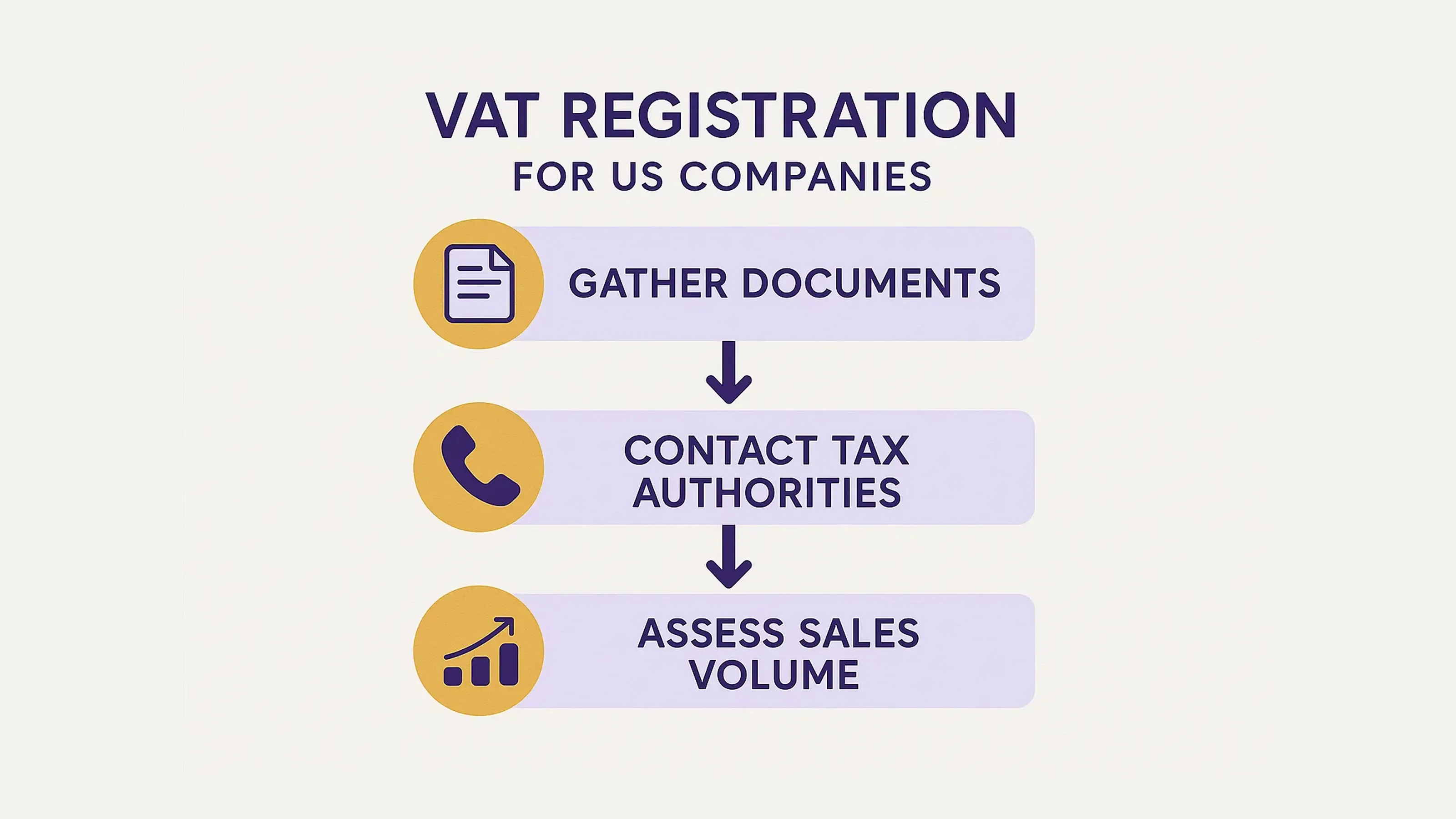Why VAT Compliance Matters for Global Expansion
US-based CFOs and tax directors expanding overseas know how important it is to stay on top of VAT requirements. As international markets continue to grow and regulatory landscapes evolve, understanding VAT and setting up the right systems can make a real difference. This guide walks you through each step, starting with initial registration and continuing through ongoing monitoring, while helping you stay compliant without unnecessary complexity. In today’s global economy, VAT compliance isn’t just a legal obligation. It’s also a way to enable smoother international operations. According to the OECD’s International VAT/GST Guidelines, the rising complexity of global trade has created a strong need for clear and consistent VAT compliance frameworks, especially for companies working across multiple jurisdictions.
1. Understanding VAT and Compliance Needs
Before you register for VAT, it’s important to grasp the basics. VAT (Value Added Tax) is a consumption tax applied to goods and services in many countries. For US companies selling internationally, knowing the obligations in each target market is vital.
-
VAT is not a US tax – it applies abroad in most international markets.
-
Staying compliant means keeping up with local VAT rules and deadlines.
-
Registering for VAT helps your business improve financial transparency and credibility.
For a full breakdown, see our Ultimate Beginner’s Guide to VAT Compliance.
What Is VAT?
VAT functions by taxing the value added at each stage of production and distribution. The final consumer bears the burden, while businesses act as tax collectors for the government - a crucial distinction for companies expanding overseas.
2. VAT Registration for US Companies: The First Step

Kick-starting your international operations means securing the proper registration. VAT registration for US companies is generally mandatory once you cross sales thresholds in another country.
-
Gather required documentation such as financial records, business licenses, and identification details.
-
Contact the tax authority of the country where you plan to sell. For example, the UK government’s VAT registration page outlines local thresholds, and similar rules apply across many EU countries.
-
Use official thresholds and guidelines published by national tax authorities or the European Commission VAT portal to determine if registration is required based on your annual sales volume.
Understanding the local VAT registration process in advance can help you avoid delays and ensure full compliance from day one.
Registration Process Tips
-
Check local thresholds: Each country sets its own VAT registration limits. Many EU nations enforce relatively low thresholds for SMEs, while the UK typically offers slightly higher limits.
-
Maintain standardized records: Well-organized financial data helps accelerate the application process.
-
Consult with experts: A tax advisor experienced in cross-border VAT compliance can help you navigate local complexities.
Note: In many EU countries, small and medium-sized enterprises represent a substantial share of VAT registrations, especially under simplified schemes introduced by the EU VAT Directive.
3. Integrating US-based VAT Solutions into Your Operations
Expanding into international markets brings new VAT responsibilities, and each country comes with its own set of rules, thresholds, and reporting standards. To stay compliant, many US companies look for support that is both reliable and tailored to their needs.
At 1stopVAT, we provide hands-on, expert-driven guidance to help simplify the process of VAT compliance across multiple jurisdictions.
Here’s what our clients appreciate most:
-
A dedicated point of contact who oversees the entire compliance journey
-
Support with VAT registration, documentation, and ongoing reporting
-
In-depth knowledge of local VAT laws and practices
-
Timely, clear communication without additional system complexity
Our goal is to make international VAT compliance straightforward, with personalized service that adapts to your business. We work closely with your team to ensure that every step - from registration to ongoing reporting - is managed efficiently and with confidence.
Interested in learning how digital tools fit into the broader VAT ecosystem?
Explore our overview:
Tax Technology Tools – VAT Compliance Automation
4. Cross-Border Compliance Checklists
Expanding internationally means juggling different compliance and reporting standards. Here’s a checklist to help you stay ahead:
-
Review each country’s VAT rate and filing deadlines.
-
Set up separate ledgers for tracking international sales.
-
Confirm that your accounting software supports multi-currency transactions.
-
Stay updated on regulatory changes in all operating regions.
Essential Steps for International VAT Reporting
-
Document retention: Save all invoices and records for the legally required duration.
-
Regular audits: Periodically review records to ensure local compliance.
-
Local consultation: Engage local tax specialists for guidance.
5. Ongoing Monitoring and Adjustments
VAT compliance isn’t a one-and-done process. Continual monitoring keeps you in step with regulatory changes and business growth.
-
Establish a periodic review schedule.
-
Update registration details promptly if your business model changes.
-
Use digital monitoring tools to track compliance in real time.
Partner with specialists in VAT Consulting for International Businesses.
Troubleshooting and Regular Updates
-
Audit trails: Ensure your system logs every transaction.
-
Regulatory updates: Keep a calendar of filing dates and legislative changes.
-
Feedback loops: Hold regular training and feedback sessions.
Cybersecurity has become a growing priority in the tax industry, with organizations steadily increasing investment to protect sensitive financial data and ensure compliance.
Quick Definition of VAT Tax Registration Services for US Companies
VAT services for US companies help manage tax registration and compliance when entering international markets. Key aspects include:
-
Supporting VAT registration when crossing foreign sales thresholds
-
Providing expert guidance on country-specific requirements
-
Monitoring regulatory changes and helping you stay compliant
-
Offering personalized support instead of relying on automated tools
Conclusion
Complying with VAT regulations is essential for US companies entering international markets. By understanding the fundamentals, registering correctly, and working with experienced professionals, you can simplify complex processes and ensure compliance across borders. With the right guidance and consistent oversight, your business can scale confidently while staying aligned with local VAT rules and reporting standards.


